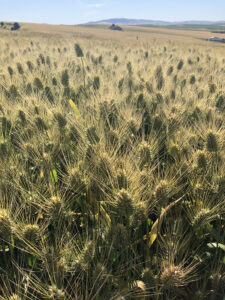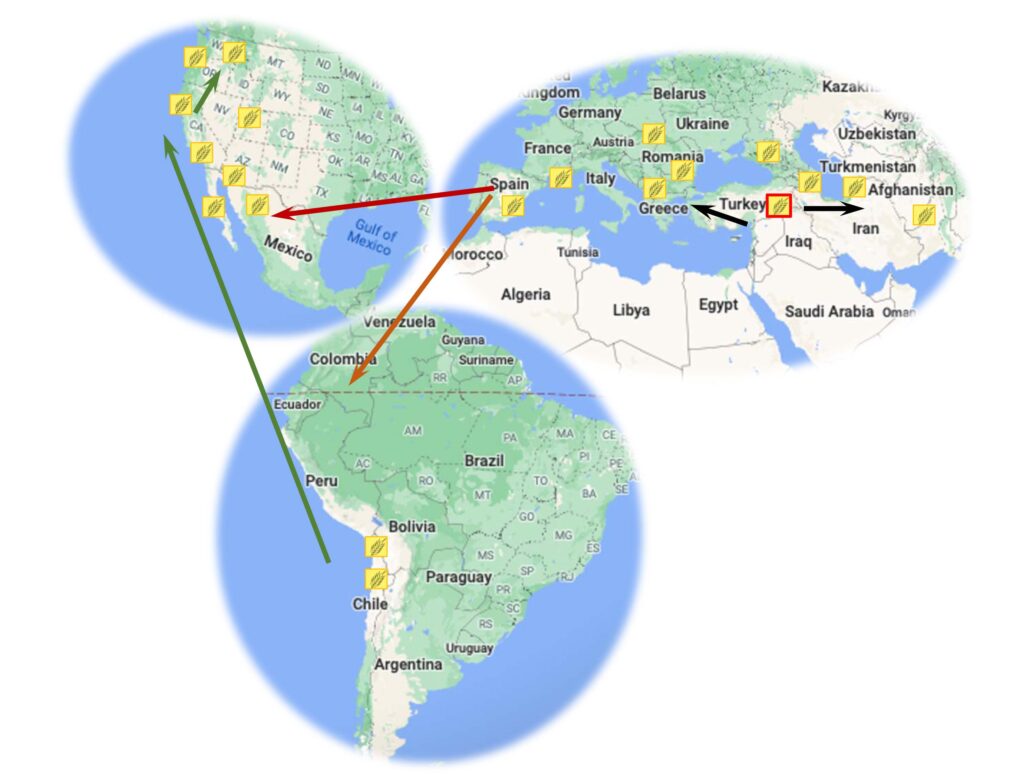By Kimberly Garland Campbell
Wheat (Triticum aestivum L.) is a primary human food grain. Global production of wheat was 775.8 million metric tons (mmt) in 2020/21, as compared to 505 mmt of rice. Club wheat is in commercial production only in the Pacific Northwest (PNW), and the breeding programs of the northwest are the only programs that breed improved cultivars.
I get asked “How did club wheat get to the PNW, and why is it only grown here?” Club wheat has a long and rich heritage, and it has been helping to feed the world for centuries.
Club wheat is prized for the quality of its flour. When milled, the bran separates more cleanly from the endosperm for club wheat than for other types of wheat. Club wheat is bred to have low gluten strength, high flour yields, very soft flour and low water absorption. These characteristics result in good cakes and very finely textured cookies. The low water absorption also creates nice batters like tempura batters.
Soft white wheat is a high-quality component of the total wheat crop with 80 percent of annual production from the PNW exported to Asian markets. Growing wheat for the export market has always been the focus of wheat production in the Inland Northwest, and club wheat has likely always been prized for its quality, even in prehistoric times.
An uncommon subclass that punches above its weight
Club wheat is a subclass of soft white wheat and is usually mixed with soft white common wheat in a blend marketed as “Western White.” Club wheat makes up a small, but significant (5-10 percent) of the annual wheat crop in the PNW. In 2020, club wheat was seeded on approximately 150,000 acres.
Genetically, both club and common are hexaploids with three closely related genomes named A, B and D. A mutation of the compactum “C” gene on chromosome 2D resulted in club wheat. It is characterized by short, compressed spikes usually less than three inches in length with 15-16 nodes on each spike. Each node forms a spikelet containing five florets. When the kernels develop in the florets, the short spike of club wheat twists, and the kernels form into a characteristic “humped” shape with a narrow crease.
Club wheat kernel size is about 10 percent smaller than common wheat, but club wheat spikes have higher floret fertility and produce up to 20 percent more grains per spike than common wheat. Although the spike morphology limits the total size of an individual spike, the grain yields of club wheat can match those of common wheat because of these trade-offs.
The early history of a unique grain
Hexaploid wheat arose about 8,000-10,000 years ago through hybridization between tetraploid Emmer and a form of wild goatgrass named Aegilops tauschii (which is not the same species as jointed goatgrass). Hexaploid wheat, including club wheat, moved with human migration from Turkey, where it originated, throughout Central Asia and into much of central and southern Europe. It can be tracked from as early as 4000 BCE in the latter Neolithic sites that were excavated in Romania, then from the Copper Age in Catalonia and southeast Iberia through the third and second millennium BCE around the Black Sea. It was found at archaeological sites in Budapest dating to the late Iron Age and also found in northeast Portugal at Terronha de Pinhovelo, which dates to the 4th and 5th Century CE.

Club wheat was found in adobe bricks in 12 of the 14 locations studied from Spanish missions that were built between 1701 through 1837 in northwest Mexico, Arizona and California. The swift shipping route between Chile and the port of San Francisco was well-established by the mid-1800s, and flour from Chile fed the gold rush population of northern California, with the “Chili club” wheat being highly valued.
Although club wheat was brought to the east coast of the U.S. from South America in 1818, it did not thrive in that environment, whereas the Chilean club wheat was ideally suited to the dry summers with low humidity that prevail in California and the western U.S.
Californians began to grow their own crops as early as 1851, and newspaper accounts at the time reported that although many varieties of wheat were cultivated, “The Chili gives general satisfaction and is more cultivated than the others.” By 1870, the U.S. had overtaken Chile as the premier producer of wheat in the Pacific.
In California, farmers grew varieties named “White Chile,” “Red Chile,” “Bearded Chile” and “Chilean club.” These club wheats were prized for their tolerance to shattering and for their standablity. These were spring habit or facultative wheats that were sown in the fall and harvested the next spring.
Finding its way to the Pacific Northwest
Wheat production in the Pacific Northwest began as early as 1829 by French-Canadian trappers on the French Prairie in the Willamette Valley of western Oregon. The Vancouver Independent, from Washington Territory, Sept. 4, 1879, reports the club wheat varieties “Little Club,” and “White Chille Club” (sic) were exhibited by Oregon at the San Francisco Mechanics Fair in 1878.
Enoch Bryan, the third president of the Washington State College of Agriculture and School of Science (now Washington State University (WSU)), recruited W.J. Spillman to teach and conduct research in agriculture in 1894. Spillman was asked to coach the football team and is the only wheat breeder who was also an undefeated college football coach.
Spillman advocated crop rotations and growing forages and legumes for sustainability, rather than so much wheat for the export market, but he realized that improvement of wheat was critical to the economy of the time. The main wheat cultivars grown were the club wheats “Little Club” and “Red Chaff” and the common wheat “Bluestem.” Little Club traced directly back to the imported Chile club wheats. Red Chaff club was the most productive, but its origin is unclear. Bluestem, or Pacific Bluestem, a common soft white wheat, was brought to the western U.S. from Australia in 1882 and was more suited to dryer conditions. All three cultivars were genetically spring habit wheats, but they were often seeded in the fall.
In search of greater winter hardiness, Spillman and students planted a variety trial in Pullman in 1899 and intercrossed the best survivors with the popular varieties. Crosses between the hard wheat variety, “Turkey,” brought to Kansas by Mennonite immigrants, and Little Club were analyzed for spike shape, the presence or absence of awns, which enabled Spillman to reconstruct the genetic experiments of Austrian botanist Gregor Mendel who is now known as the “father of genetics.” The most popular club wheat selected from these crosses was “Hybrid 128” from a cross between “White Track” and Little Club.
By 1901, Little Club, also known as Golden Gate Club, was grown along the entire West Coast and was the dominant form of wheat grown in Washington state. The soft grain was exported to western Europe and Asia to be used for biscuit and confectionery products due to the soft kernels and poor breadmaking properties. Wheat quality wasn’t assayed for breeding programs until 1941, so the end-use quality was a bit hit or miss.

Red line: 4,000 BCE-1800. Wheat is tracked across Europe at archaeological sites in Romania, Catalonia, Iberia and the Black Sea to Budapest and through Spain to Portugal, then on to South America and Mexico.
Green line: 1800-1900. Shipping routes from Chile to California expedite wheat’s progress to North America. By the 1830s, wheat finds its home in the Pacific Northwest.
The making of modern club
Major early club wheat cultivars included Spillman’s Hybrid 128 and “Hybrid 143;” the high yielding but disease susceptible “Alicel” and “Elgin” from Oregon; “Elmar;” and “Omar.” In particular, Omar, developed by O.A. Vogel, was resistant to several races of common bunt and had outstanding club wheat quality. It occupied the greatest production area of any club wheat when it was grown on more than 1.5 million acres in the PNW in 1959. Unfortunately, Omar was susceptible to stripe rust, and production dropped after the major stripe rust epidemic of 1960. This reduction in acreage coincided with the release of the semidwarf “Gaines” and “NuGaines,” which had adult plant resistance to stripe rust and significantly better grain yields than Omar. However, the end-use quality of both was lacking. Soon, the Japanese market started specifically sourcing the high-quality club wheat from the PNW for their products.
“Moro” club wheat was released by C. Rohde from the Oregon State University research station in 1965 with resistance to multiple diseases and extremely fast emergence in dry soils. The cultivation of Moro helped to establish deep furrow dryland agriculture in the drier areas of the Columbia basin. “Paha,” developed by R.E. Allan of the U.S. Department of Agriculture (USDA) at Pullman, was the first semidwarf club wheat, and it had a race-specific gene for stripe rust resistance. “Tyee” and “Tres” were released after stripe rust overcame the resistance in Paha. Frustrated, Allan developed two multilines of club wheat, “Crew” and “Rely,” in order to have longer lasting stripe rust resistance. Rely was the most successful club wheat grown in the 1990s with durable resistance for nearly 20 years. It was finally replaced by “Bruehl,” which combined high grain yield, seedling and adult plant resistance to stripe rust and resistance to speckled snowmold, released by WSU in 2001.
The most recent club wheat cultivars developed by the USDA and WSU wheat breeding program in Pullman are “ARS Crescent,” “Pritchett,” “Castella” and “Cameo.” They all have excellent club wheat quality, competitive grain yields and multigene resistance to stripe rust and soil-borne disease.
Club wheat is a big reason why the PNW is a world-renowned wheat-producing region. When you are next considering a change to your wheat varieties, I encourage you to consider planting more club.
This article originally appeared in the November 2021 issue of Wheat Life Magazine.

Kimberly Garland Campbell, Ph.D.
Kimberly Garland Campbell, Ph.D., is a USDA plant research geneticist and club wheat breeder at the USDA-ARS in Pullman, Washington. Her research focuses on genetics and breeding of wheat responses to abiotic and biotic stress; breeding wheat for winter survival; enhancing quality, functionality and marketability in the in the western U.S. of soft white and club wheat; and control of rusts of cereal crops. Read more about Dr. Campbell.
